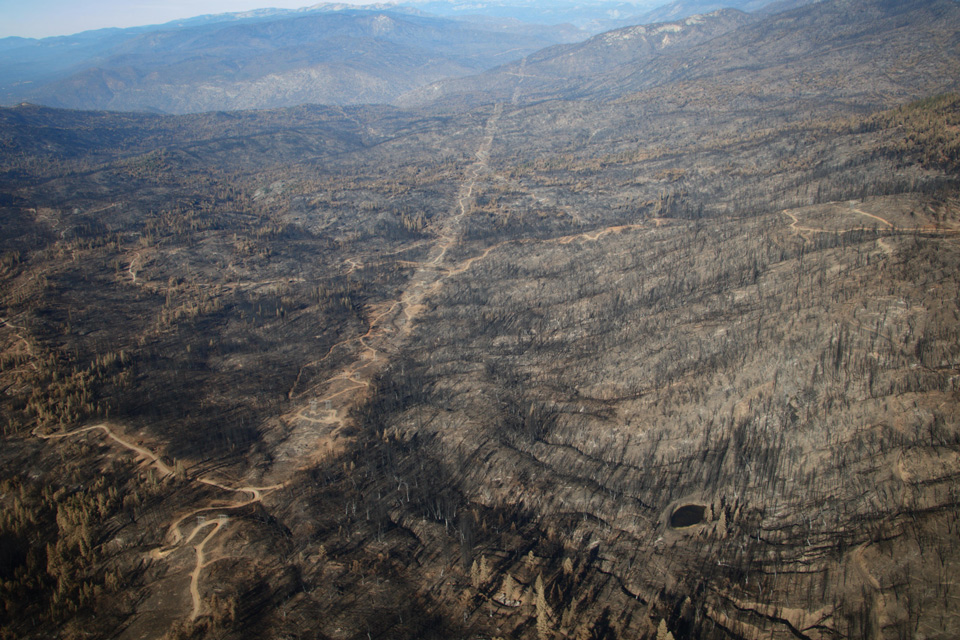
2020 California: Sierra National Forest Creek Fire burn area south of Shaver Lake
Credit: Inciweb
March 10, 2022 - By Devon Boer - Mendocino County grows trees. It always has and always will. But what is done with our forest resources remains at the heart of a cyclical conversation that has gone on for several decades.
Now that conversation is intensifying anew in our county, with debate over management of the Jackson Demonstration State Forest—the largest of California's 10 state-run demonstration forests and a model for multi-use forestry practices. The forest serves as a laboratory for University of California forest ecology researchers, as a treasured recreational resource and as the home of sustainable timber practices important to our economy.
In 1947, the state of California purchased the 48,652-acre JDSF property to demonstrate that previously cut-over timberland, if properly managed, can become a valuable asset that offers a multitude of benefits. The results of that experiment have proven positive for Mendocino County.
Timber is an agricultural commodity here, employing foresters, loggers and sawmill workers, and supporting numerous additional jobs. The work of our local harvesters, including members of the Mendocino County Farm Bureau, is governed under California's stringent forest practice rules and administered by licensed professionals.
But now that work is being paused. In the face of anti-logging protests, Cal Fire on Jan. 19 suspended additional timber sales for 2022 as it reviews future forest management plans for the demonstration forest.
The current debate centers on whether the cutting of timber resources in the forest should continue to be included in the overall JDSF management strategy. The forest has a timber inventory of approximately 2.3 billion board-feet of conifer trees that grow about 53 million board-feet each year. On average, JDSF harvests 14.3 million board-feet of conifer timber each year, which is approximately 27% of the annual growth.
Mendocino County Farm Bureau's Natural Resources Committee has been meeting with our affected membership, lawmakers and state agency representatives to seek a broader conversation on the future of JDSF and the ability to continue harvesting timber while providing important stewardship of the property. The anti-logging sentiment fanned during recent protests should not steer the discussion of smart, sustainable forest management in Mendocino County and throughout the state.
The ideal outcome is for all sides to have an honest discussion about timber management on JDSF, through one of several existing platforms to do so.
One of those, the Jackson Advisory Group, was formed in 2008 to work with the public and numerous stakeholders. It provides recommendations to Cal Fire and the California Board of Forestry and Fire Protection on the review of the JDSF management plan, ongoing implementation issues and other policy matters relevant to the forest.
The committee reached out on multiple occasions for discussions with those opposing current and future logging on demonstration forest lands. But overtures seeking open dialogue have by and large been ignored.
The JDSF management plan was last updated in 2016, as the result of a thorough review process that allowed for extensive public comment and feedback. The management plan directs the forest for 10-15 years, with the Board of Forestry able to adopt revisions in the interim.
As a result, another opportunity exists for interested groups and individuals to offer suggestions or air concerns during the next scheduled JDSF management plan update.
Approved timber harvesting plans on the demonstration forest go through a rigorous review process. They are scrutinized by multiple agencies, which review California Environmental Quality Act requirements and provide opportunities for public input.
Over its history as a state-run forest, the JDSF has demonstrated its value in environmental stewardship and has provided important research data on forest sustainability and watershed protection—all while supporting recreation and sustainable logging.
Amid perilous wildfire threats, sound management practices are being discussed to improve fire prevention, carbon sequestration and watershed health, as well as to protect habitat for fish and wildlife. As the timber debate flares up anew, it seems counter intuitive to be arguing once again about whether to allow trees to be harvested under strict mandates that are designed to protect the forest ecosystem.
Cal Fire is central to working with the Board of Forestry, the governor and state elected officials to steer the future of forest management. If the ability to harvest timber on the largest state demonstration forest is eliminated or significantly reduced, it will weaken forest-management approaches that have been improved upon over many years and that remain vital today.
Mendocino County Farm Bureau will continue to engage on this issue to help our member commercial forest landowners, loggers, foresters, mill owners, truck drivers and forest-product representatives. They are caught in the middle as the future of timber harvesting at the JDSF hangs in the balance.
We hope the conversations we are having with decision makers will not fall on deaf ears and that a lasting solution can be found to allow JDSF to continue to be managed under the multi-use model that has supported valuable research, recreation and our local economy since 1947.
(Devon Boer is executive director of the Mendocino County Farm Bureau and may be contacted at director@mendofarmbureau.org.)
ABOUT CALIFORNIA FARM BUREAU FEDERATION
The California Farm Bureau Federation works to protect family farms and ranches on behalf of nearly 32,000 members statewide and as part of a nationwide network of more than 5.5 million Farm Bureau members.
Source: Reprinted with permission CFBF








